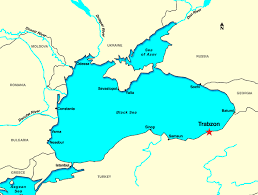Via
Dark Roasted Blend:

Spectacularly located on a cliff side in northeast Turkey near the Black Sea, today
Sumela is an abandoned relic of 2500 years of cultural history and fifteen centuries of religious heritage. The Greek Orthodox monastery, founded in the late 4th century AD is about 25 miles from the port of Trapezus, as it was known in classical times, Trebizond, as known during the centuries of Byzantine rule and today as Trabzon.


Greeks first came to the Pontic shores, settling Trapezus, in the 6th century BC. By the first century BC the area was under Roman rule. As Christianity became recognized as the official religion of the Empire in the 4th century AD, monasteries began to be established. Sumela went through many cycles of construction, decay and renewal in its history. The first major reconstruction was at the direction of Belisarius, the leading general of the Emperor Justinian who had led the reconquest of North Africa, Sicily and Italy during the brief Roman revival of the western empire during the mid-6th century.
Its most famous period, and the one from which most of its buildings date, was during the Empire of Trebizond (1204-1461). When the Fourth Crusade went awry in 1204 and the Western Crusaders sacked Constantinople instead of reconquering Jerusalem the Byzantine Empire was splintered with the Latin Crusaders occupying Constantinople and three Byzantine successor states arising of which Trebizond was one.

Even though the Empire of Nicea succeeded in ousting the Latins from Constantinople and then absorbing the Despotate of Epirus it was never able to subdue Trebizond which finally fell to the Turks in 1461, eight years after the Ottoman conquest of Constantinople. Even after the conquest, the privileges and rights of the Sumela monastery were preserved under the protection of the Ottoman sultans and most of the Greeks who inhabited the south shore of the Black Sea remained under their rule.
The Monastery continued to operate and preserve a vibrant religious heritage for the Greek population of Trebizond until the early 20th century. It was only in the wake of World War One that things changed. Turkey was defeated and under the Treaty of Sevres in 1920 it was partitioned with the Allies occupying Constantinople and large "zones of influence" being granted to Italy, France and Greece. A new Turkish nationalist movement arose under the leadership of Mustafa Kemal Attaturk which was implacably opposed to the terms of Sevres and began mobilizing an army of resistance. At the same time the Greek government decided to attempt to

reestablish a Greek hegemony across Asia Minor and its armies advanced from its zone on the Aegean Coast of Turkey onto the central plateau almost reaching Ankara. The Turkish armies under Attaturk counterattacked and forced the Greeks to retreat and then threw them out of their zone of influence. The other Allies lost their appetite for fighting to retain their zones of influence and today's Turkey was created by the Treaty of Lausanne (1923). Under the terms of the Treaty there was an exchange of populations between Turkey and Greece with one and a half million Greeks leaving Turkish lands where their ancestors had lived for twenty five centuries and 500,000 Turks being expelled from Greece. As part of the exchange, 350,000 Greeks left Trebizond and the Sumela Monastery was abandoned.
The departing monks were not allowed to bring any possessions and buried their most precious icons which were rescued during a secret 1930 visit by one of the monks - they now reside in Greece.
In 2010, for the first time since 1923, the Turkish government allowed the Orthodox liturgy to be performed at Sumela and the government is now funding restoration work for the site which has become a tourist attraction.


No comments:
Post a Comment